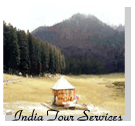Dalhousie is a gateway to the ancient Chamba Hill State , now Chamba District of the Himachel Pradesh, India . The hill station of Dalhousie is full of charm and holds lingering echoes.
Its Area
It covers an area of about 14 sq. km and is built on five hills - Kathlog, Potreyn, Tehra, Bakrota and Balun. |
 |
Dalhousie is a quiet town, with a sense of enchantment. This hill station spreads over five low-level hills at the western edge of the Dhauladhar range, just east of the Ravi River . The picture sque town is interspersed with the colonial-era buildings, low roofed stalls and hotels. The pine-covered slopes around it are intersected with paths and treks, which are ideal for short undemanding walks.
The hill resort of Dalhousie is associated with the British. The sunshine accompanied with the forests of pine and oak, beautiful scenery and the slopes of the Dhauladhar range attracted the British. The place was picture perfect for the sanatorium of the Europeans.
Its Name History
It was Sir Donald McLeod, was named Dalhousie, after Lord Dalhousie, the first British Governor General of India . Dalhousie has charming architecture, including beautiful churches. Its location presents panoramic views of the plains - and like a long silverline, the river Ravi twists and turns below Dalhousie. Dalhousie is built by the British as per their own style as they wanted to establish a sanatorium for Europeans on the outer slopes of the Dhauladhar range. Then Maharaja of Chamba was offered handsome amount for this place. He paid Rs 2300 as compensation to the Chamba state for the transfer of this place and its nearby places like Bakrota, Tehra, and Kathlog etc. to the Government of India. Sir Donald McLeod recommended the British to name, the new sanatorium as Dalhousie, after Lord Dalhousie, the first British Governor General of India in the year 1854.
Thus, this beautiful hill station came into being covering an area of 14 sq kms .
|

